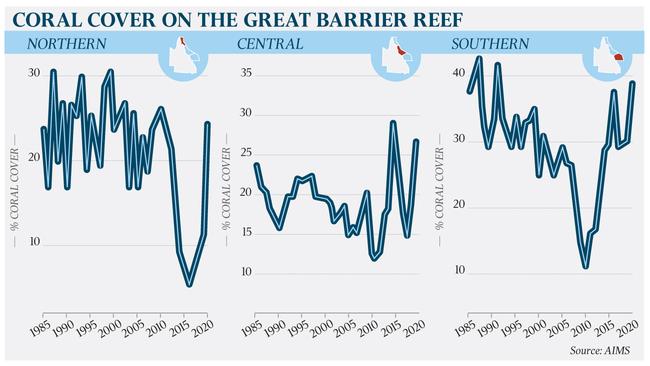Great Barrier Reef gets ‘a breather but it’s not out of climate danger yet’
Australian scientists say the resurgence in coral across the Great Barrier Reef occurred after it was given a ‘breather’ from extreme weather events and not because it is out of danger from climate change.

Australian scientists say the resurgence in coral across the Great Barrier Reef occurred after it was given a “breather” from extreme weather events and not because it is out of danger from climate change.
The full report of the Australian Institute of Marine Science’s latest report, released on Monday, found hard coral cover increased across at least 69 of 127 reefs surveyed, despite suffering some underwater heat stress.
The federal government’s independent marine agency, which has been surveying the reef annually since 1985, also reported that last year’s coral bleaching had not killed off coral to the same extent as similar events in 2016 and 2017.
“Results from 2021 revealed minimal loss of coral from the 2020 coral bleaching event, as only a few survey reefs experienced heat stress during 2020 above the threshold at which extensive coral mortality is expected,” the report said. “In periods free from acute disturbances, most GBR coral reefs demonstrate resilience through the ability to begin recovery. However, reefs of the GBR continue to be exposed to cumulative stressors, and the prognosis for the future disturbance regime is one of increased and longer-lasting marine heatwaves and a greater proportion of severe tropical cyclones.”
AIMS chief executive Paul Hardisty said the survey showed the reef experienced coral growth during periods of low disturbance but the increased occurrence of severe weather events had stifled that regrowth in recent years.

“Coral reefs can recover from disturbances if given enough time and the reef has been given a breather over the last year,” he said. “Another year like this will continue the reef’s recovery but the increasing prominence of climate-related extreme weather events and crown-of-thorns starfish outbreaks is causing more severe and frequent pressures, giving the reef fewer opportunities like this to recover.”
AIMS said since 2009, the Great Barrier Reef had been hit with three mass coral bleaching events, a wave of crown-of-thorns starfish outbreaks and 17 cyclones.
The report was released as UNESCO’s World Heritage Committee will later this week consider whether the site should be formally declared “in danger”.
Environment Minister Sussan Ley will use the report in her final push to lobby committee members against ratifying the draft ruling.
The Australian Marine Conservation Society said the report should not persuade UNESCO to back down on the ruling, which could “drive” government to take action to tackle climate change.
“Given a period free from cyclones and heatwaves, some coral species can come back quickly following bleaching events,’’ Coral reef scientist and AMCS board member Selina Ward said.
“The AIMS data are promising but it is important to note the recovery of hard coral cover in the surveys has largely been driven by fast-growing branching and table corals, which tend to be the most susceptible species to bleaching events in warmer waters as well as being easily broken in cyclones and the preferred food for crown of thorns starfish.
“Given the increased frequency of bleaching events, another heating event could wipe away this good progress,” Dr Ward said.




To join the conversation, please log in. Don't have an account? Register
Join the conversation, you are commenting as Logout